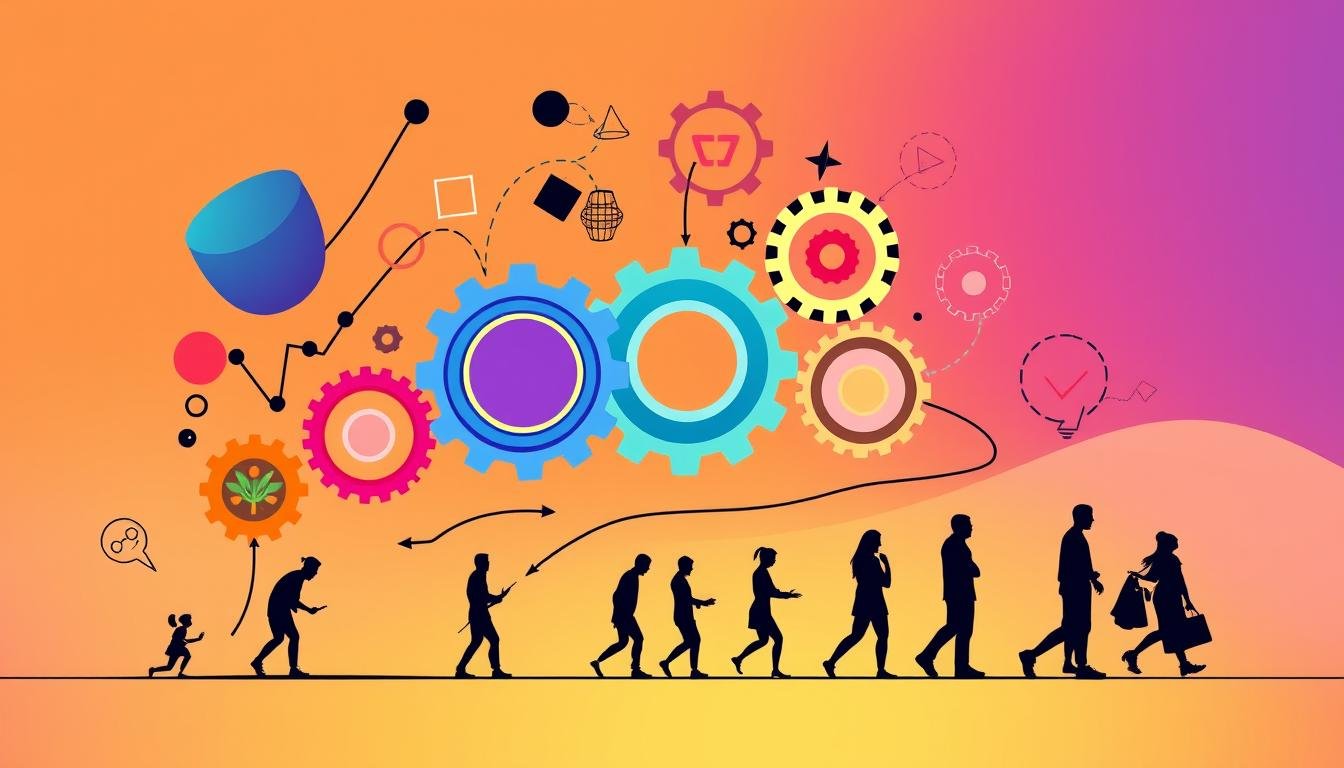Understanding Change Management Theory Essentials
Have you ever thought about why 70% of all change efforts fail, even with careful planning? The business world is always changing, bringing new challenges. Change Management Theory is key to understanding how to handle these changes. It helps organizations see what makes them adaptable and successful.
This theory includes processes, models, and strategies for managing change. In today’s fast-paced world, knowing these is crucial. Not understanding change can cause resistance and slow growth. But, with a clear grasp of Change Management Theory, an organization can smoothly move through changes.
Key Takeaways
- Understanding Change Management Theory is critical for successful organizational change.
- Effective change strategies can enhance employee engagement and reduce resistance.
- Clear communication is paramount in facilitating smooth transitions.
- Stakeholder involvement significantly impacts the success of change initiatives.
- Recognizing the unique challenges organizations face during change is essential.
What is Change Management?
Change management is a structured way to plan, implement, and guide people and teams through changes. It aims to make changes happen smoothly and effectively. With fast technology changes and market shifts, knowing how to manage change is key for companies to stay ahead.
Definition and Importance of Change Management
Change management helps people accept new changes and makes sure new strategies work well. There are many tools and techniques to help with this. Companies that plan their changes well are more likely to stay competitive and succeed.
Statistics show that about 50% of change efforts fail. This shows we need a strong plan to help us through changes.
Why Organizations Must Embrace Change
Change is a big part of today’s business world. Companies need to keep up with new tech, market changes, and surprises to do well. By embracing change, companies can be more innovative, boost morale, and improve leadership.
Many companies use models like Lewin’s, McKinsey 7-S, and Kotter’s to manage change. These models offer strategies for different situations and challenges in companies.
| Change Model | Best Suited For | Key Focus Areas |
|---|---|---|
| Lewin’s Model | Small to midsize businesses undergoing restructuring | Unfreeze, Change, Refreeze |
| McKinsey 7-S | Large organizations in strategic transformations | Strategy, Structure, Systems, Shared Values, Skills, Style, Staff |
| Kotter’s 8-Step | Businesses undergoing significant change initiatives | Focus on people, their psychology, and engagement |
| ADKAR Model | Organizations implementing technology or process changes | Awareness, Desire, Knowledge, Ability, Reinforcement |
| Bridges Transition Model | Businesses facing leadership transitions | Emotional transition stages: Ending, Neutral Zone, New Beginning |
Key Principles of Change Management Theory
Understanding how organizations change is key to successful management. It’s important to know the different types of change. This knowledge helps leaders make better decisions and plan for the future.
Understanding Organizational Change
Change can happen in many ways, each needing its own approach. Some changes are small, improving what we already do. Others are big, changing how we work and think. Leaders must pick the right strategy based on the change’s nature.
The Role of Change Management Models
Change management models help guide us through big changes. Models like Kotter’s 8-Step Change Model show the steps to follow. They focus on creating urgency, setting clear goals, and removing obstacles.
Using these models, leaders can improve communication and engage stakeholders. This ensures everyone is on the same page during changes.
Common Change Management Models
Learning about different frameworks for change management is key to success. Many popular models exist, each with its own tools and views for handling changes in organizations. This section looks at several important models. It also compares them to help change managers pick the best one for their needs.
Overview of Popular Models
- Kurt Lewin’s Change Management Model: This model breaks change into three stages: unfreezing, movement, and refreezing. It stresses the need to prepare for change before starting.
- McKinsey 7-S Framework: It has seven elements: strategy, structure, systems, shared values, style, staff, and skills. This model checks how well an organization works during changes.
- ADKAR Model: Focuses on five key areas: Awareness, Desire, Knowledge, Ability, and Reinforcement. It promotes a structured way to handle both personal and organizational change.
- Kübler-Ross Change Curve: This model shows the emotional steps people go through during change, including Denial, Anger, Bargaining, Depression, and Acceptance.
- Kotter’s 8-Step Change Model: By John P. Kotter, this model aims to build urgency and guide change, ending with sustaining the change.
- Bridges Transition Model: This framework separates change from transition. It looks at the emotional and psychological sides of change, focusing on how people adjust to new situations.
- Stephen Covey Change Management Model: Based on personal growth, this model talks about habits that help during change.
- Roger’s Diffusion of Innovations: This model looks at how new ideas spread, highlighting the role of people in adopting changes.
- Prosci Change Management Model: It marks three main eras in model development and gives a structured way to apply change management strategies.
- Complex Adaptive Systems Model: This model sees organizations as dynamic systems needing adaptive strategies for change.
Comparative Analysis of Change Models
The table below compares key elements of some popular change management models.
| Model | Focus | Key Stages/Elements | Applicability |
|---|---|---|---|
| Kurt Lewin’s Model | Process of change | Unfreezing, Movement, Refreezing | Works well in many organizational settings |
| McKinsey 7-S | Internal alignment | Strategy, Structure, Systems, Shared Values, Style, Staff, Skills | Great for strategic planning and evaluation |
| ADKAR | Individual transitions | Awareness, Desire, Knowledge, Ability, Reinforcement | Good for personal change efforts |
| Kübler-Ross Curve | Emotional journey | Denial, Anger, Bargaining, Depression, Acceptance | Helps understand emotional changes |
| Kotter’s 8 Steps | Implementation roadmap | Creating urgency, Establishing vision, Communicating, Empowering action, Creating short-term wins, Consolidating gains, Anchoring changes | Useful for organizational changes |
Change Management Strategies for Successful Implementation
Effective change management strategies are key to success. Clear communication is crucial. It helps all employees understand the reasons and steps of the changes. This method tackles concerns, builds trust, and lowers resistance.
Effective Communication Techniques
Good communication is essential in managing change. Leaders need to explain the reasons for changes clearly and listen to what employees say. This helps in engaging stakeholders and spotting potential issues early. Using clear communication plans keeps everyone informed and on the same page with the company’s goals.
Importance of Stakeholder Involvement
Getting stakeholders involved is vital for change success. It builds trust and teamwork during the change process. Companies should welcome input from all levels. By asking for feedback and involving stakeholders in decisions, commitment to change grows. An inclusive approach helps overcome resistance to change.
| Strategy | Description | Benefits |
|---|---|---|
| Clear Communication | Articulating the vision and purpose behind changes | Reduces uncertainty among employees |
| Feedback Mechanisms | Establishing channels for employee feedback | Identifies areas of resistance early |
| Inclusive Engagement | Involving stakeholders in the decision-making process | Increases trust and collaboration |
| Training Programs | Providing education on new processes or systems | Enhances employee confidence in adapting to change |
| Continuous Improvement | Regularly reviewing and adapting strategies | Ensures alignment with long-term goals |
Change Management Process Steps
The change management process is about planning and doing things to help an organization change smoothly. Getting ready for change is key to a smooth transition. This means making sure everything is set up and the culture is ready, and talking well with employees. Doing this helps reduce pushback and makes the change easier to accept.
Preparing for Change
First, it’s important to be clear about what the change is for and what we want to achieve. Being clear helps avoid confusion and sets the stage for the change. Finding out who might support or question the change helps us make plans that meet different needs. It’s also important to understand how change affects people, as they might feel sad about leaving old ways behind.
Embedding Changes in Organizational Culture
After making changes, it’s key to make sure they stick around. Checking on how changes are going and listening to what employees say helps us make needed changes. Setting up new rules and rewards helps keep the changes going. It’s important to build a culture where everyone is committed to change. This way, the new ways become the usual way of doing things.
| Change Management Position | Average Salary | Projected Job Openings (2022-2032) |
|---|---|---|
| Change Management Analyst | $79,051 | 92,900 annually |
| Change Manager | $96,645 | |
| Organizational Development Consultant | $98,341 | |
| Organizational Consultant | $70,827 | |
| Organizational Change Manager | $108,684 | |
| Overall Change Management Roles | Varies |
Conclusion
Understanding Change Management Theory is key for companies facing big changes. It helps them see the need for change, look at the risks and benefits, and plan well. This makes them more adaptable.
Using the right strategies, like top-down and bottom-up, is important. It’s about finding what works best with the company’s culture. Overcoming challenges like employee resistance and good communication is crucial. This helps teams move forward smoothly.
Successful change management means better decisions and a more involved workforce. It helps companies do well against future challenges. Models like Kurt Lewin’s show the importance of a step-by-step approach to change. This way, companies can not just survive but thrive, staying ahead in the long run.
Source Links
- Change Management: From Theory to Practice
- 13 Types of Change of Management Models You Should Know
- Lewin’s 3-Stage Model of Change Theory: Overview
- Top 10 change management models: A comparison guide
- What Is Change Management? | Definition from TechTarget
- The Four Principles Of Change Management
- Key Principles of Change Management
- 10 Proven Change Management Models (2024)
- Change Management Models
- 7 Reasons Why Change Management Strategies Fail and How to Avoid Them – Professional & Executive Development | Harvard DCE
- 5 Steps in the Change Management Process | HBS Online
- The Change Management Process: What Is It and Who Is It For?
- 5 critical steps in the change management process – Work Life by Atlassian
- What Is Change Management? Benefits, Principles (2024)
- Change Management: The Impact on Organizations | Monitask
- Where Do Models for Change Management, Improvement and Implementation Meet? A Systematic Review of the Applications of Change Management Models in Healthcare
- Lewin’s Change Management Model: 2022







